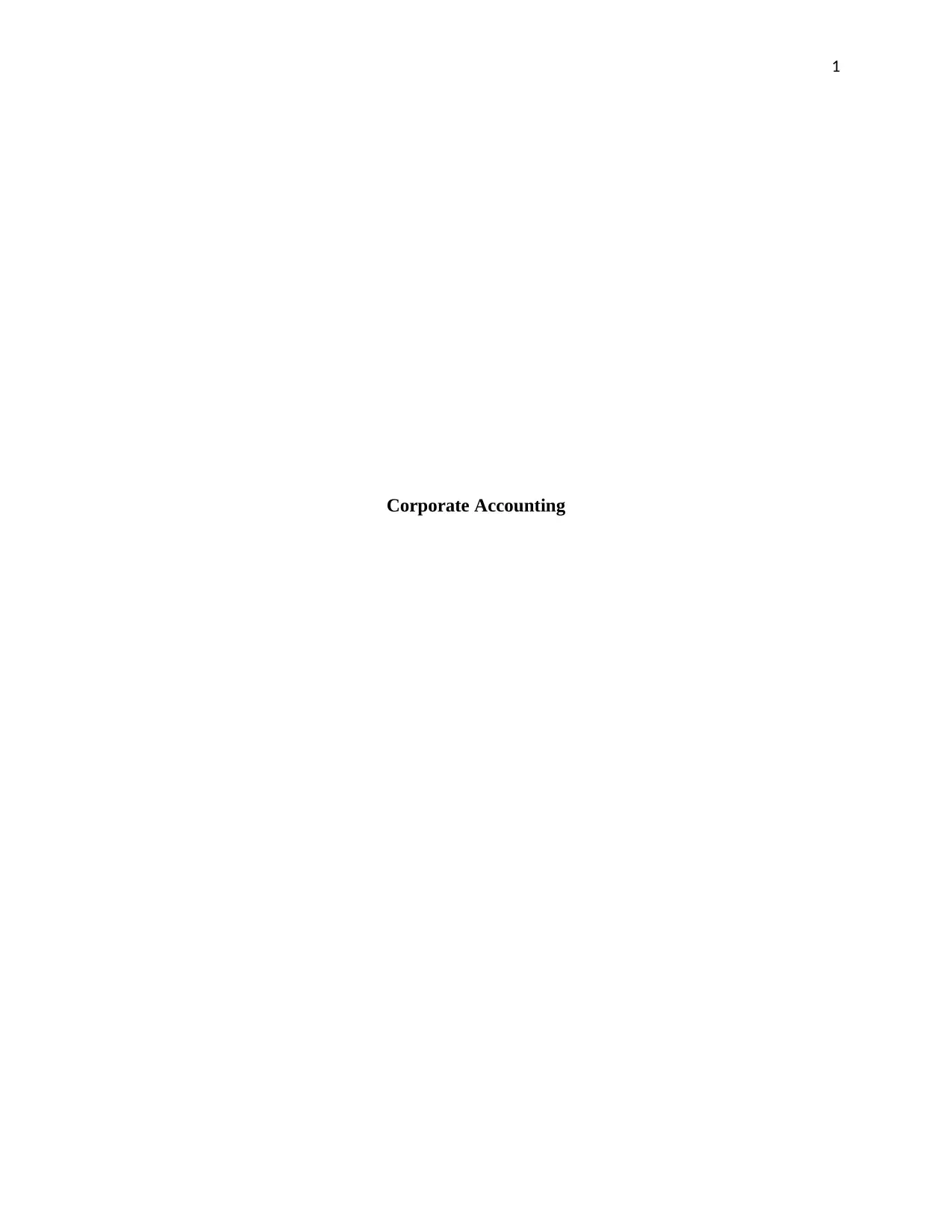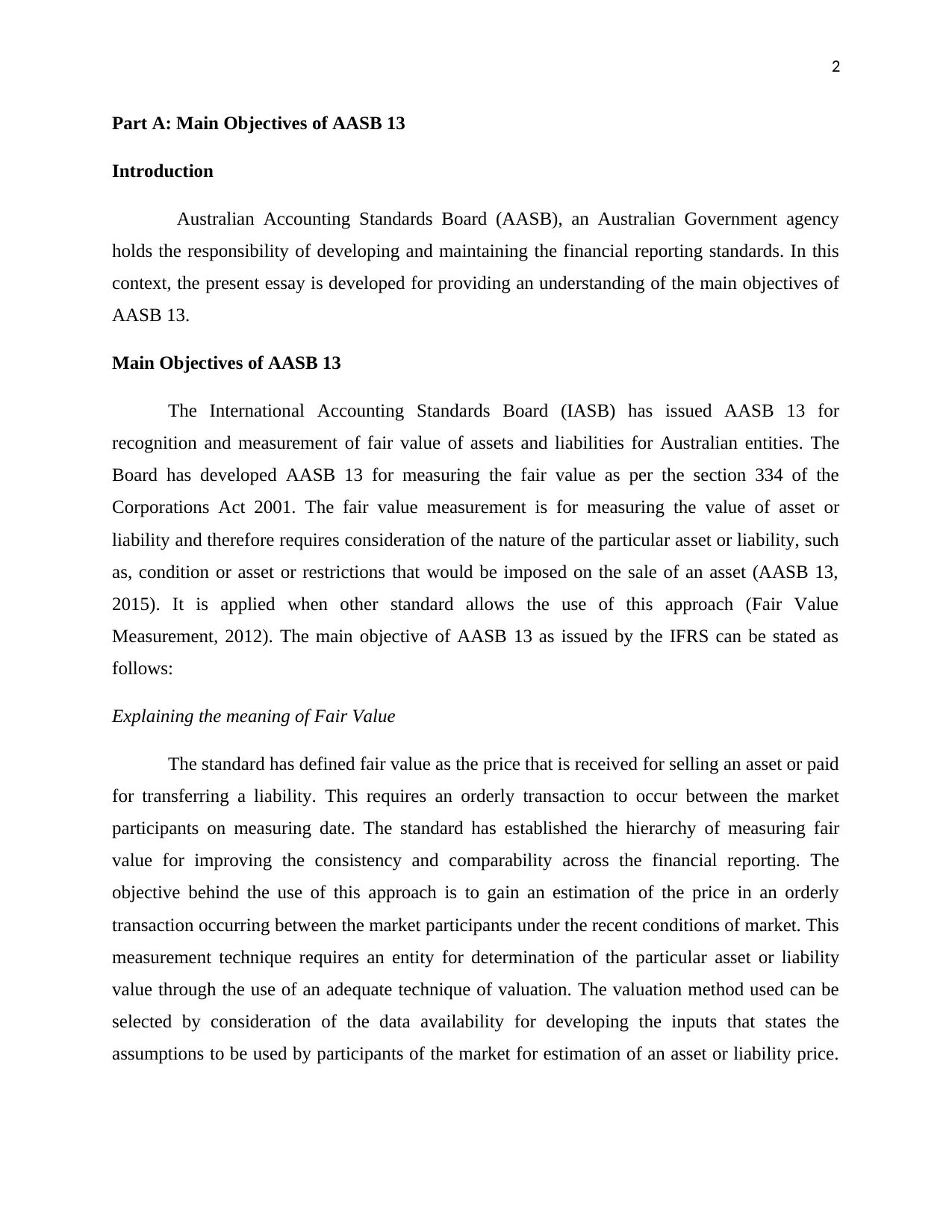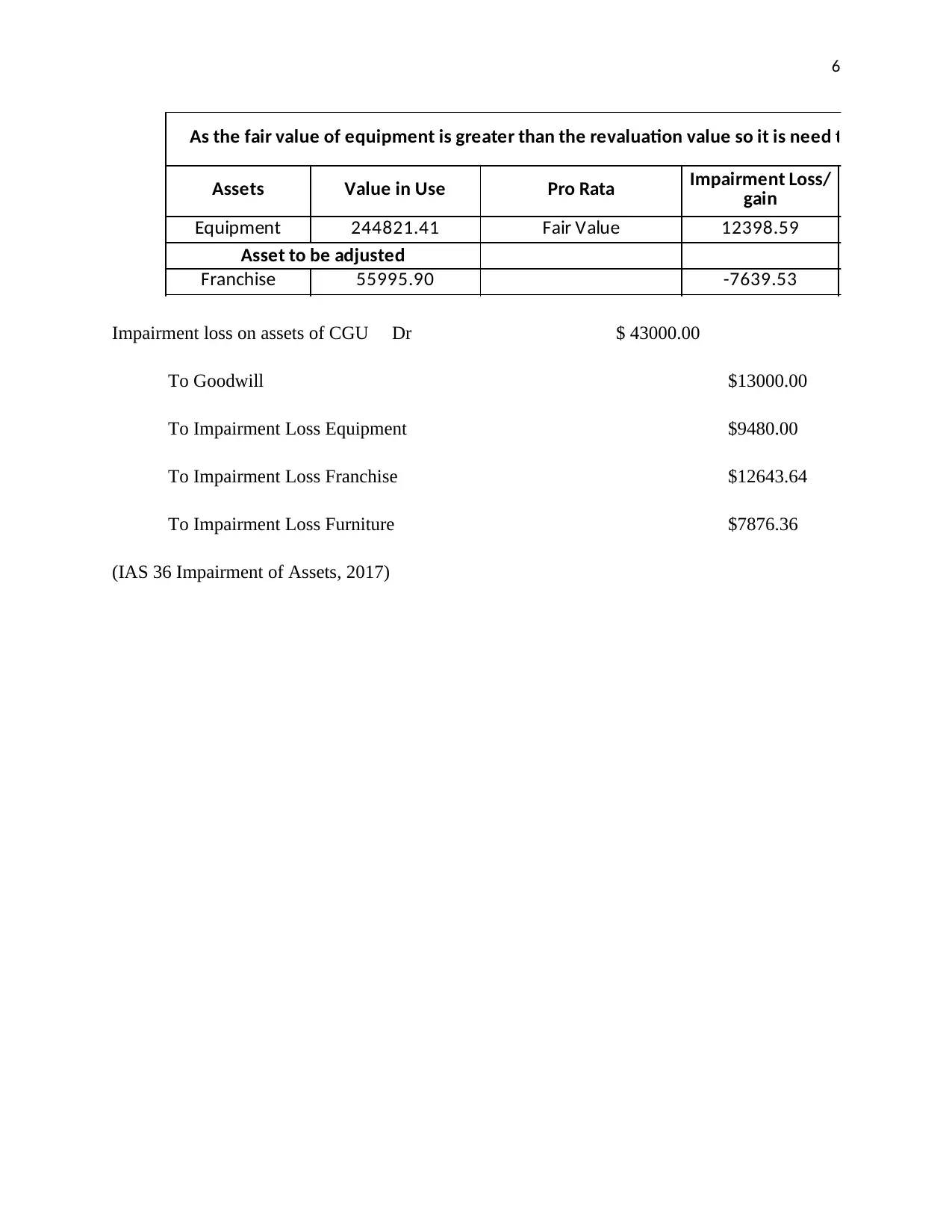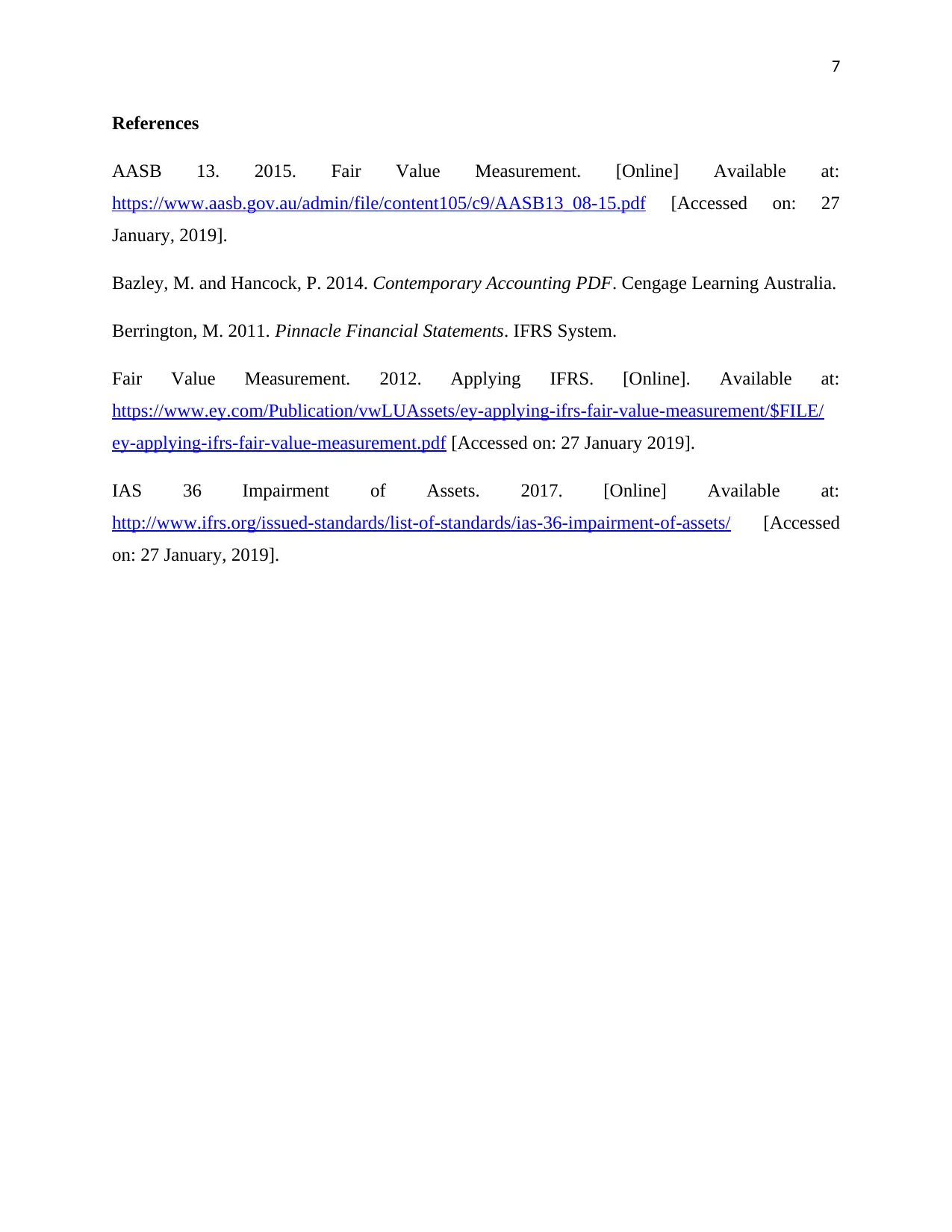Accounting Assignment: AASB 13 Objectives and Impairment Loss Analysis
VerifiedAdded on 2023/04/25
|7
|1457
|324
Homework Assignment
AI Summary
This assignment delves into the core principles of AASB 13, focusing on the objectives of fair value measurement as defined by the Australian Accounting Standards Board (AASB). The essay component explains the meaning of fair value, the measurement of an entity's fair value, and the importance of disclosing fair value measurements, emphasizing the standard's role in improving consistency and comparability in financial reporting. The second part of the assignment involves a practical application, where the student calculates and presents journal entries for an impairment loss scenario for Gali Ltd. This includes determining the impairment loss, allocating the loss across various assets (equipment, franchise, and furniture), and preparing the necessary journal entries to reflect the impairment in the company's financial records. The assignment demonstrates the student's understanding of accounting standards and their ability to apply them to real-world scenarios.

1
Corporate Accounting
Corporate Accounting
Paraphrase This Document
Need a fresh take? Get an instant paraphrase of this document with our AI Paraphraser

2
Part A: Main Objectives of AASB 13
Introduction
Australian Accounting Standards Board (AASB), an Australian Government agency
holds the responsibility of developing and maintaining the financial reporting standards. In this
context, the present essay is developed for providing an understanding of the main objectives of
AASB 13.
Main Objectives of AASB 13
The International Accounting Standards Board (IASB) has issued AASB 13 for
recognition and measurement of fair value of assets and liabilities for Australian entities. The
Board has developed AASB 13 for measuring the fair value as per the section 334 of the
Corporations Act 2001. The fair value measurement is for measuring the value of asset or
liability and therefore requires consideration of the nature of the particular asset or liability, such
as, condition or asset or restrictions that would be imposed on the sale of an asset (AASB 13,
2015). It is applied when other standard allows the use of this approach (Fair Value
Measurement, 2012). The main objective of AASB 13 as issued by the IFRS can be stated as
follows:
Explaining the meaning of Fair Value
The standard has defined fair value as the price that is received for selling an asset or paid
for transferring a liability. This requires an orderly transaction to occur between the market
participants on measuring date. The standard has established the hierarchy of measuring fair
value for improving the consistency and comparability across the financial reporting. The
objective behind the use of this approach is to gain an estimation of the price in an orderly
transaction occurring between the market participants under the recent conditions of market. This
measurement technique requires an entity for determination of the particular asset or liability
value through the use of an adequate technique of valuation. The valuation method used can be
selected by consideration of the data availability for developing the inputs that states the
assumptions to be used by participants of the market for estimation of an asset or liability price.
Part A: Main Objectives of AASB 13
Introduction
Australian Accounting Standards Board (AASB), an Australian Government agency
holds the responsibility of developing and maintaining the financial reporting standards. In this
context, the present essay is developed for providing an understanding of the main objectives of
AASB 13.
Main Objectives of AASB 13
The International Accounting Standards Board (IASB) has issued AASB 13 for
recognition and measurement of fair value of assets and liabilities for Australian entities. The
Board has developed AASB 13 for measuring the fair value as per the section 334 of the
Corporations Act 2001. The fair value measurement is for measuring the value of asset or
liability and therefore requires consideration of the nature of the particular asset or liability, such
as, condition or asset or restrictions that would be imposed on the sale of an asset (AASB 13,
2015). It is applied when other standard allows the use of this approach (Fair Value
Measurement, 2012). The main objective of AASB 13 as issued by the IFRS can be stated as
follows:
Explaining the meaning of Fair Value
The standard has defined fair value as the price that is received for selling an asset or paid
for transferring a liability. This requires an orderly transaction to occur between the market
participants on measuring date. The standard has established the hierarchy of measuring fair
value for improving the consistency and comparability across the financial reporting. The
objective behind the use of this approach is to gain an estimation of the price in an orderly
transaction occurring between the market participants under the recent conditions of market. This
measurement technique requires an entity for determination of the particular asset or liability
value through the use of an adequate technique of valuation. The valuation method used can be
selected by consideration of the data availability for developing the inputs that states the
assumptions to be used by participants of the market for estimation of an asset or liability price.

3
The determination of the fair value at initial recognition should consider the factors that are
particular for an asset or liability transaction (AASB 13, 2015).
However, in the case when an asset or liability price cannot be determined, an entity is
required to measure their current value through the use of other valuation technique. The selected
technique should result in maximizing the use of relevant observable inputs. The standard has
placed emphasis on determination of the assets and liabilities prices as they are key financial
elements during financial reporting. As such, it can be said that the main objective of the
standard is to develop a fair value measurement framework that is applicable for initial and
subsequent measurement of fair value as stated by the AASB (Bazley and Hancock, 2014).
Measurement of an Entity Fair Value
The standard has proposed the measurement of fair value only for measuring the value of
assets or liabilities of an entity. This should take into account the characteristics of an asset or
liability at the time of their measurement. The characteristics should consider the asset or
liability location and the restrictions associated with the asset sale. An orderly transaction
required for an asset sale or liability transfer is stated to occur in a principal market or in the
most advantageous market. The principal market is different for various entities and it should be
selected on the basis of an entity nature that results in the selection of most advantageous market
(AASB 13, 2015).
The situations characterized by the absence of such a market then the information related
to price should be gathered from an observable market. Also, it is assumed that market
participants act in the best economic interest. The assumptions are developed by considering the
features that distinguishes the market participants. The price should not include the cost of
transport as per the Australian Accounting Standard Board. The measurement effect will differ
depending on the characteristic of the market participants. The fair value measurement hierarchy
can be used either for assessing the value of stand-alone or group of assets or liabilities
(Berrington, 2011).
Disclosure of fair value measurement
The determination of the fair value at initial recognition should consider the factors that are
particular for an asset or liability transaction (AASB 13, 2015).
However, in the case when an asset or liability price cannot be determined, an entity is
required to measure their current value through the use of other valuation technique. The selected
technique should result in maximizing the use of relevant observable inputs. The standard has
placed emphasis on determination of the assets and liabilities prices as they are key financial
elements during financial reporting. As such, it can be said that the main objective of the
standard is to develop a fair value measurement framework that is applicable for initial and
subsequent measurement of fair value as stated by the AASB (Bazley and Hancock, 2014).
Measurement of an Entity Fair Value
The standard has proposed the measurement of fair value only for measuring the value of
assets or liabilities of an entity. This should take into account the characteristics of an asset or
liability at the time of their measurement. The characteristics should consider the asset or
liability location and the restrictions associated with the asset sale. An orderly transaction
required for an asset sale or liability transfer is stated to occur in a principal market or in the
most advantageous market. The principal market is different for various entities and it should be
selected on the basis of an entity nature that results in the selection of most advantageous market
(AASB 13, 2015).
The situations characterized by the absence of such a market then the information related
to price should be gathered from an observable market. Also, it is assumed that market
participants act in the best economic interest. The assumptions are developed by considering the
features that distinguishes the market participants. The price should not include the cost of
transport as per the Australian Accounting Standard Board. The measurement effect will differ
depending on the characteristic of the market participants. The fair value measurement hierarchy
can be used either for assessing the value of stand-alone or group of assets or liabilities
(Berrington, 2011).
Disclosure of fair value measurement
⊘ This is a preview!⊘
Do you want full access?
Subscribe today to unlock all pages.

Trusted by 1+ million students worldwide

4
The third objective of this accounting standard AASB 13 is that entity must disclose
information about the fair value accounting. The disclosed information should provide assistance
to the users of the financial statements for measuring at fair value on regular and irregular basis
in balance sheet particularly after the initial recognition. The disclosure also helps in providing
the information to the users about the valuation techniques used to develop the values of assets
and liabilities (AASB 13, 2015). There must be proper disclosure of impact of the measurement
approach used on the financial reports used for the particular financial year in case of recurring
fair value measurements.
Overall it can be said that it is a technique that determines the fair value of an asset or
liability based on the market conditions and by not considering the entity specific factors. Market
value or market information of only some of the assets and liabilities is available as it is not
possible that every assets and liabilities are transacted in market. But it is important to note that
fair value for assets and liabilities can be determined accurately for those whose market value is
available readily (AASB 13, 2015).
Conclusion
As such, it can be summarized from the overall discussion held within the essay that the
standard has been developed by the AASB board for defining the fair value. The fair value
hierarchy is established by the standard that has defined the specific conditions and criteria that
is required to be considered for measurement and disclosure of the fair value.
Part B: Journal Entries of impairment loss in book of Gali Limited as on 30 June, 2015
Account Carrying Amount
Equipment $ 266,700.00
Franchise $ 61,000.00
Furniture $ 38,000.00
Inventory $ 16,000.00
Goodwill $ 13,000.00
Total CA $ 394,700.00
The third objective of this accounting standard AASB 13 is that entity must disclose
information about the fair value accounting. The disclosed information should provide assistance
to the users of the financial statements for measuring at fair value on regular and irregular basis
in balance sheet particularly after the initial recognition. The disclosure also helps in providing
the information to the users about the valuation techniques used to develop the values of assets
and liabilities (AASB 13, 2015). There must be proper disclosure of impact of the measurement
approach used on the financial reports used for the particular financial year in case of recurring
fair value measurements.
Overall it can be said that it is a technique that determines the fair value of an asset or
liability based on the market conditions and by not considering the entity specific factors. Market
value or market information of only some of the assets and liabilities is available as it is not
possible that every assets and liabilities are transacted in market. But it is important to note that
fair value for assets and liabilities can be determined accurately for those whose market value is
available readily (AASB 13, 2015).
Conclusion
As such, it can be summarized from the overall discussion held within the essay that the
standard has been developed by the AASB board for defining the fair value. The fair value
hierarchy is established by the standard that has defined the specific conditions and criteria that
is required to be considered for measurement and disclosure of the fair value.
Part B: Journal Entries of impairment loss in book of Gali Limited as on 30 June, 2015
Account Carrying Amount
Equipment $ 266,700.00
Franchise $ 61,000.00
Furniture $ 38,000.00
Inventory $ 16,000.00
Goodwill $ 13,000.00
Total CA $ 394,700.00
Paraphrase This Document
Need a fresh take? Get an instant paraphrase of this document with our AI Paraphraser

5
Gali Ltd calculated the value in use of
the division to be:
$
335,700.00
Fair value of equipment less cost of
disposal is
$
257,220.00
*Note Value of inventory is not liable for impairment therefore it must be deducted from
the value of CA
Net Carrying amount after deduction of inventory value $ 378,700.00
Less: Value in Use $ 335,700.00
Total Impairment to be made $ 43,000.00
Less: Total Value of Goodwill to be impaired $ 13,000.00
Impairment to be done for other assets $ 30,000.00
Assets Impairment Loss
Goodwill $ 13,000.00 $ 13,000.00 $ -
Equipment $ 266,700.00 578700/795700*60000 $ 21,878.59 $ 244,821.41
Franchise $ 61,000.00 133000/795700*60000 $ 5,004.10 $ 55,995.90
Furniture $ 38,000.00 84000/795700*60000 $ 3,117.31 $ 34,882.69
Carrying Value of
assets
Impairment on pro rata
basis
Carrying Value
(Adjusted)
Items not to be
adjusted
Items to be
adjusted
Furniture $ 38,000.00 84000/795700*60000 $ 3,117.31 $ 34,882.69
Total $ 365,700.00 $ 30,000.00
Value in use $ 335,700.00
As the fair value of equipment is greater than the revaluation value so it is need to be adjusted
Gali Ltd calculated the value in use of
the division to be:
$
335,700.00
Fair value of equipment less cost of
disposal is
$
257,220.00
*Note Value of inventory is not liable for impairment therefore it must be deducted from
the value of CA
Net Carrying amount after deduction of inventory value $ 378,700.00
Less: Value in Use $ 335,700.00
Total Impairment to be made $ 43,000.00
Less: Total Value of Goodwill to be impaired $ 13,000.00
Impairment to be done for other assets $ 30,000.00
Assets Impairment Loss
Goodwill $ 13,000.00 $ 13,000.00 $ -
Equipment $ 266,700.00 578700/795700*60000 $ 21,878.59 $ 244,821.41
Franchise $ 61,000.00 133000/795700*60000 $ 5,004.10 $ 55,995.90
Furniture $ 38,000.00 84000/795700*60000 $ 3,117.31 $ 34,882.69
Carrying Value of
assets
Impairment on pro rata
basis
Carrying Value
(Adjusted)
Items not to be
adjusted
Items to be
adjusted
Furniture $ 38,000.00 84000/795700*60000 $ 3,117.31 $ 34,882.69
Total $ 365,700.00 $ 30,000.00
Value in use $ 335,700.00
As the fair value of equipment is greater than the revaluation value so it is need to be adjusted

6
As the fair value of equipment is greater than the revaluation value so it is need to be adjusted
Assets Value in Use Pro Rata
Equipment 244821.41 Fair Value 12398.59
Asset to be adjusted
Franchise 55995.90 -7639.53
Impairment Loss/
gain
Impairment loss on assets of CGU Dr $ 43000.00
To Goodwill $13000.00
To Impairment Loss Equipment $9480.00
To Impairment Loss Franchise $12643.64
To Impairment Loss Furniture $7876.36
(IAS 36 Impairment of Assets, 2017)
As the fair value of equipment is greater than the revaluation value so it is need to be adjusted
Assets Value in Use Pro Rata
Equipment 244821.41 Fair Value 12398.59
Asset to be adjusted
Franchise 55995.90 -7639.53
Impairment Loss/
gain
Impairment loss on assets of CGU Dr $ 43000.00
To Goodwill $13000.00
To Impairment Loss Equipment $9480.00
To Impairment Loss Franchise $12643.64
To Impairment Loss Furniture $7876.36
(IAS 36 Impairment of Assets, 2017)
⊘ This is a preview!⊘
Do you want full access?
Subscribe today to unlock all pages.

Trusted by 1+ million students worldwide

7
References
AASB 13. 2015. Fair Value Measurement. [Online] Available at:
https://www.aasb.gov.au/admin/file/content105/c9/AASB13_08-15.pdf [Accessed on: 27
January, 2019].
Bazley, M. and Hancock, P. 2014. Contemporary Accounting PDF. Cengage Learning Australia.
Berrington, M. 2011. Pinnacle Financial Statements. IFRS System.
Fair Value Measurement. 2012. Applying IFRS. [Online]. Available at:
https://www.ey.com/Publication/vwLUAssets/ey-applying-ifrs-fair-value-measurement/$FILE/
ey-applying-ifrs-fair-value-measurement.pdf [Accessed on: 27 January 2019].
IAS 36 Impairment of Assets. 2017. [Online] Available at:
http://www.ifrs.org/issued-standards/list-of-standards/ias-36-impairment-of-assets/ [Accessed
on: 27 January, 2019].
References
AASB 13. 2015. Fair Value Measurement. [Online] Available at:
https://www.aasb.gov.au/admin/file/content105/c9/AASB13_08-15.pdf [Accessed on: 27
January, 2019].
Bazley, M. and Hancock, P. 2014. Contemporary Accounting PDF. Cengage Learning Australia.
Berrington, M. 2011. Pinnacle Financial Statements. IFRS System.
Fair Value Measurement. 2012. Applying IFRS. [Online]. Available at:
https://www.ey.com/Publication/vwLUAssets/ey-applying-ifrs-fair-value-measurement/$FILE/
ey-applying-ifrs-fair-value-measurement.pdf [Accessed on: 27 January 2019].
IAS 36 Impairment of Assets. 2017. [Online] Available at:
http://www.ifrs.org/issued-standards/list-of-standards/ias-36-impairment-of-assets/ [Accessed
on: 27 January, 2019].
1 out of 7
Related Documents
Your All-in-One AI-Powered Toolkit for Academic Success.
+13062052269
info@desklib.com
Available 24*7 on WhatsApp / Email
![[object Object]](/_next/static/media/star-bottom.7253800d.svg)
Unlock your academic potential
Copyright © 2020–2025 A2Z Services. All Rights Reserved. Developed and managed by ZUCOL.





